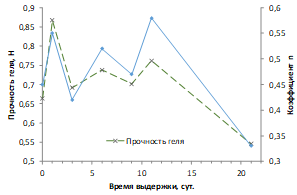МЕХАНИЧЕСКИЕ СВОЙСТВА РАСТВОРОВ И ГЕЛЕЙ АГАРА, ПРИГОТОВЛЕННЫХ С ИСПОЛЬЗОВАНИЕМ ВОДЫ, ПОДВЕРГНУТОЙ ВОЗДЕЙСТВИЮ ЭЛЕКТРОМАГНИТНОГО ПОЛЯ
УДК 532.135
Аннотация
В работе представлены результаты, продолжающие цикл исследований о влиянии высокочастотного поля на воду, которая использовалась в дальнейшем для приготовления растворов агара. Были изучены прочность агарового геля (желе) в зависимости от условий полевого воздействия на воду. Показано, что прочность геля сложным образом зависит от частоты полевой предобработки и времени выдержки воды после полевого воздействия. Анализ реологических свойств проводился с использованием аппроксимационного уравнения Оствальда-де Виля. Проанализирована зависимость реологической константы (коэффициента консистенции) от частоты полевого воздействия и времени выдержки после него. Зависимости, как и наблюдалось ранее, представляют несистемные ломаные кривые. Проведено сопоставление реологических свойств и прочности геля, приготовленных не в воде, прошедшей идентичную полевую обработку. Результаты можно условно разделить на три группы: синбатное изменение, антибатное изменение и смена зависимостей после 9 суток выдержки воды. Показано, что прочность и вязкость агарового геля в основном уменьшается. Сложные зависимости прочности и вязкости от факторов воздействия на воду объясняются на основе предположения о сложной и многоуровневой исходной структуре воды и ее изменением как под действием электромагнитного поля, так и со временем в результате теплового движения.
Скачивания
Metrics
Литература
Bertasa M., Dodero A., Alloisio M., Vicini S., Riedo C., Sansonetti A., Scalarone D., Castellano M. European Polymer Journal, 2020, vol. 123, 109442. DOI: 10.1016/j.eurpolymj.2019.109442.
Dodero A., Vicini S., Alloisio M., Castellano M. J. Mater. Sci., 2019, vol. 54, pp. 8034–8046. DOI: 10.1007/s10853-019-03446-3.
Jakubczyk E., Gondek E., Kamińska-Dwórznicka A., Samborska K., Wiktor A., Królikowski K. Food Hydrocoll., 2019, vol. 91, pp. 66–75. DOI: 10.1016/j.foodhyd.2019.01.013.
Dodero A., Williams R., Gagliardi S., Vicini S., Alloisio M., Castellano M. Carbohydr. Polym., 2019, vol. 203, pp. 349–355. DOI: 10.1016/j.carbpol.2018. 09.072.
Nishinari K., Watase M. Carbohydr. Polym., 1983, vol. 3, pp. 39–52. DOI: 10.1016/0144-8617(83)90011-5.
Rhein-Knudsen N., Ale M.T., Ajalloueian F., Yu L., Meyer A.S. Food Hydrocoll., 2017, vol. 63, pp. 50–58. DOI: 10.1016/j.foodhyd.2016.08.023.
Labropoulos K.C., Niesz D.E., Danforth S.C., Kevrekidis P.G. Carbohydr. Polym., 2002, vol. 50, pp. 393–406. DOI: 10.1016/S0144-8617(02) 00084-X
Shipunov B.P., Markin V.I., Koptev V.I. Khimiya rastitel'nogo syr'ya, 2018, no. 1, pp. 53–60. DOI: 10.14258/jcprm.2018013720. (in Russ.).
Stekhin A.A., Yakovleva G.V. Strukturirovannaya voda: Nelineynyye effekty. [Structured Water: Nonlinear Effects]. Moscow, 2008, 320 p. (in Russ.).
Usanov A.D., Ulyanov S.S., Ilyukhina N.S. Optics and Spectroscopy, 2016, vol. 120, no. 1, pp. 82–85. DOI: 10.1134/S0030400X16010239.
Esmaeilnezhad E., Choi H.J., Schaffie M., Gholizadeh M., Ranjbar M. Journal of Cleaner Production, 2017, vol. 161, pp. 908–921. DOI: 10.1016/j.jclepro.2017.05.166.
Veselinovic D., Velikic Z. Journal of the Serbian Chemical Society, 2016, vol. 81, issue 12, pp. 1407–1414. DOI: 10.2298/JSC160407082V.
Chirkova V.Yu., Sharlayeva Ye.A., Stas I.Ye. Bulletin of the University of Karaganda-Chemistry, 2019, no. 94, pp. 51–55. DOI: 10.31489/2019Ch2/51-55.
Calabro E., Magazu S. Electromagnetic Biology and Medicine, 2019, vol. 38, no. 4, pp. 271–278. DOI: 10.1080/15368378.2019.1641720.
Shipunov B.P., Timiryazev A.V., Kondratova Ye.V. Butlerovskiye soobshcheniya, 2011, vol. 24, no. 1, pp. 105–109. (in Russ.).
Wang G., Yan Y.-J., Zhang Y., Zhou H., Cao S.-X., Wang J.-G. Chemical Engineering (China), 2014, vol. 42, no. 12, pp. 6–10. DOI: 10.3969/j.issn.1005-9954.2014.12.002.
Shipunov B.P., Ryabykh A.V. Khimiya rastitel'nogo syr'ya, 2019, no. 3, pp. 235–240. DOI: 10.14258/jcprm.2019034456. (in Russ.).
Shipunov B.P., Markin V.I. Khimiya rastitel'nogo syr'ya, 2020, no. 1, pp. 73–80. DOI: 10.14258/jcprm.2020017373. (in Russ.).
Drozdova V.A., Nasonova V.V., Semonova A.A., Gorbunova N.A. Vso o myase, 2016, no. 6, pp. 15–17. (in Russ.).
Vinogradov G.V., Malkin A.YA. Reologiya polimerov, Moscow, 1977, 215 p. (in Russ.).
Mel'chenko N.A. Vestnik DVO RAN, 2010, no. 1, pp. 65–74. (in Russ.).
Malenkov G.G. Zhurnal strukturnoy khimii, 2006, vol. 47, no. 6, pp. 5–35. (in Russ.).
Churakov S.V., Kalinichev A.G. Zhurnal strukturnoy khimii, 1999, vol. 40, no. 4, pp. 673–680. (in Russ.).

Copyright (c) 2023 Химия растительного сырья

Это произведение доступно по лицензии Creative Commons «Attribution» («Атрибуция») 4.0 Всемирная.

This work is licensed under a Creative Commons Attribution 4.0 International License.
Авторы, которые публикуются в данном журнале, соглашаются со следующими условиями:
1. Авторы сохраняют за собой авторские права на работу и передают журналу право первой публикации вместе с работой, одновременно лицензируя ее на условиях Creative Commons Attribution License, которая позволяет другим распространять данную работу с обязательным указанием авторства данной работы и ссылкой на оригинальную публикацию в этом журнале.
2. Авторы сохраняют право заключать отдельные, дополнительные контрактные соглашения на неэксклюзивное распространение версии работы, опубликованной этим журналом (например, разместить ее в университетском хранилище или опубликовать ее в книге), со ссылкой на оригинальную публикацию в этом журнале.
3. Авторам разрешается размещать их работу в сети Интернет (например, в университетском хранилище или на их персональном веб-сайте) до и во время процесса рассмотрения ее данным журналом, так как это может привести к продуктивному обсуждению, а также к большему количеству ссылок на данную опубликованную работу.











